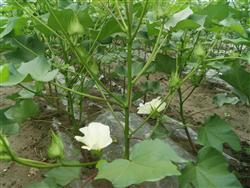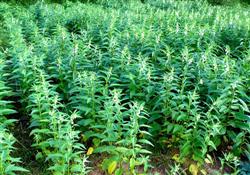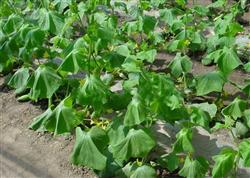How to prevent cotton from rotten bolls (peaches) in rainy season?

How to prevent cotton from rotten bolls (peaches) in rainy season? Please introduce the rainy season can refer to the following methods to prevent cotton boll rot (peach): 1, scientific fertilization: at present, most of the cultivation is insect-resistant cotton, generally requires a large amount of base fertilizer and bud fertilizer, do not apply flower and boll fertilizer, in order to prevent excessive growth, shade aggravation. It is necessary to control nitrogen, increase phosphorus and potassium, and cooperate with foliar fertilization. Such as spraying with a mixture of 2% urea and 2% potassium dihydrogen phosphate or other foliar fertilizer. 2. Reasonable irrigation and drainage: water imbalance will hinder metabolism and cause bud and boll shedding. However, the flower and boll period is in the rainy season, generally does not need irrigation, mainly to pay attention to cotton field drainage, in order to prevent waterlogging, to ensure that cotton fields do not produce excessive humidity. Avoid noon when watering. 3. Timely chemical control: chemical control can effectively control overgrowth, improve ventilation and light transmission conditions in cotton fields, reduce shedding and increase yield. It can be sprayed once before and after the early flowering stage, and the dosage can be sprayed 45 ~ 90 grams per hectare according to the growth situation. 4. Fine pruning: the content of fine pruning at flower and boll stage includes hitting top, removing superfluous buds, hitting group tips, removing old leaves, and so on. It plays an important role in reducing cotton bud and boll shedding, increasing ventilation and ventilation in cotton field, maturing early and improving cotton quality. Generally, the top is in the middle or late July, and the group tip can be concentrated at the appropriate time according to the local effective flowering period, and the cotton field with high density and sufficient fertilizer and water can also be carried out in different times. To cover cotton fields, old leaves should be beaten and empty branches should be cut as soon as possible. The order of operation is first the main stem and then branching, first the base and then the middle and lower part. Through pruning, we can create a population with ventilation and light in the field and reasonable distribution of branches and leaves. 5. Middle ploughing and soil cultivation: during the flowering and boll setting period, due to irrigation and precipitation, the soil is easy to consolidate and the air permeability is poor, so it is necessary to carry out mid-tillage and soil cultivation. And there are many storms and heavy rains in the cotton boll period, resulting in falling and rotten bolls, so it is necessary to cultivate the soil before the wind and rain, and correct it in time after the wind and rain. 6. pushing plants and ridges: for greedy green late-maturing and shady cotton fields, you can push cotton plants by hand on sunny days to form a ventilation passage between rows, and then push the two rows of cotton plants apart a week later, so that they can be pushed apart alternately, which can improve ventilation and light transmission conditions, help cool down, prevent rotten bolls, and promote precocious maturity. 7. eliminate pests: the resistance of insect-resistant cotton to Helicoverpa armigera in the later stage is not as strong as that in the early stage, and cotton bollworm and red bollworm often cause boll rot, so measures should be taken to control them. Drug control can generally be controlled by enemy killing, kung fu 450 ml ~ 900 ml spray per hectare, or 600 ml ~ 900 ml per hectare with cotton lingbao, Mianling, etc., or spray control with phoxim, monocrotophos and omethoate. 8. Cure and protect bolls: the main diseases causing rotten bolls are red rot, powdery mildew, black fruit disease, blight and so on. When the boll rot occurs in the cotton field, use 40% carbendazim glue suspension 800 times in time, or spray 90% ethyl phosphate aluminum powder 600 times or 70% mancozeb wettable powder 600 times. Spray 75 kg ~ 100 kg per mu, once every 10 days, for 3 ~ 4 days. 9. Grab the yellow bell: picking the yellow bell is an effective measure to ensure that the peach does not rot in the rain and the peach does not rot. Generally speaking, when the bell skin turns yellow, it is most important to pick it in time, especially before the overcast and rain comes. 10, drug ripening: 15 days before the local dry frost, and when most cotton bolls have basically matured, spraying ethephon 500PPM solution, 50kg per mu, can open bolls early and reduce rotten bolls. But pay attention to spray evenly, especially on the green bell. Click to get more cotton planting technology click to get more food crop planting technology
- Prev

What are the main management of planting black sesame in summer?
What are the main management of planting black sesame in summer? Please give an introduction to planting black sesame in summer management can refer to the following points: first, timely determine seedlings, check seedlings to fill gaps: because sesame seeds are small and have a large number of seedlings, seedlings should be sparse when they grow into the first pair of true leaves, seedlings should be sparse when they grow to 2-3 pairs of true leaves, and seedlings should be fixed when 4 pairs of true leaves grow.
- Next

What causes cotton to prevent acute wilting after rain?
What causes cotton to prevent acute wilting after rain? Please introduce the causes of acute wilting of cotton: first, the lack of oxygen in the soil. After waterlogging, the root oxygen supply is insufficient, which suffocates the root and affects the normal absorption function of the root. The longer the suffocation time is, the more serious the root damage is. Second, improper fertilization. One-time chase.
Related
- The first cup of black tea in spring, the flavor and history of tea gardens in Kenya, Africa
- The computer can not only choose potatoes, but also grow tea rice. AI will grow winter oolong tea champion.
- It is not only the inflated tea bitten by insects, but also engraved with the four seasons tea in Beipu.
- The Oriental Beauty Tea Festival in Zhuxian County takes the stage at the weekend to experience the plus-size feast of oil tea.
- & quot; Oriental Beauty Tea & Exploration of Emei in Hsinchu, the hometown of quot;
- The new variety of strawberry "Tainong 1" dessert is the first choice with mellow aroma. Crimson gorgeous
- History of Tea in Taiwan: from Wild Inner Mountain to Export Tea Garden
- Two types of Taiwan Oriental Beauty Black Tea won the British three-Star Award for Childhood Tea Xiang Zhang Jiaqi changed from pilot to champion tea maker.
- Banana species and varieties: the planting history of Taiwan Xianren banana and dwarf banana is long, is banana disease resistant?
- Coffee planting Technology: Qianjie Coffee from Seedling to harvesting

